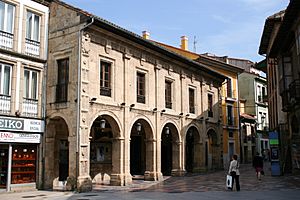Llano Ponte Palace facts for kids
The Llano Ponte Palace (also known as Casa-Palacio de García-Pumarino) is a beautiful old building. You can find it in the city of Avilés, in Asturias, Spain. It stands right on the corner of the Spanish Square. For a long time, it was a private home. But in the 20th century, it changed a lot! It became a school, then a place for nuns, and finally, a movie theater. Today, it's a special part of Avilés's historic area.
Contents
A Palace's Story: From Home to Theater
This amazing palace was built between 1700 and 1706. An architect named Francisco Menéndez Camina designed it. A rich man named Rodrigo García Pumarino asked for it to be built. He had made a lot of money in Peru and then came back to Avilés.
The palace was one of the first big buildings on the Plaza de España (Spanish Square). It was part of a time when Avilés was growing and adding many new buildings in the Baroque style.
What the Palace Looks Like
The front of the palace is very special. It's made of large blocks of sandstone. It looks a bit like the town hall, but it has much more decoration! There are five arches along the bottom part, with fancy columns between them. These columns have pretty flower designs called rosettes.
Above the arches, on the second floor, are five balconies. Each balcony is right above an arch below it. On one corner of the building, you can see shields. These shields show the symbols of the families who used to live in the palace.
When it was first built, the palace had a courtyard and even a small chapel. But over the years, many changes and updates have happened. Because of this, you can't see the original courtyard or chapel anymore. The inside of the palace was completely changed in the 1900s.
New Owners and New Uses
After Rodrigo García Pumarino passed away, the palace changed hands. It was traded for another property with the Llano Ponte family. In 1774, Francisco de Llano Ponte became the new owner. He made many repairs and updated the building. Several generations of the Llano Ponte family lived there. But by the 1900s, no one was living in the palace anymore.
In 1928, the palace became a school called "El Liceo Avilesino." The school stayed open until the Spanish Civil War forced it to close. After the war, in 1939, a group of Carmelite nuns moved in. Their own convent in Oviedo had been destroyed. The nuns lived in the palace until 1945.
Then, in 1946, a movie company called "Prafel" got permission to turn the building into a cinema. They named the movie theater "Martha and Mary." This was a tribute to a famous book with the same name. The author of the book, Armando Palacio Valdes, had actually lived across the street from the palace when he was a child!
In 1955, the old part of Avilés was declared a special historic and artistic area. The Llano Ponte Palace was one of the important buildings included in this special protection.
See also
 In Spanish: Palacio de Llano Ponte para niños
In Spanish: Palacio de Llano Ponte para niños


